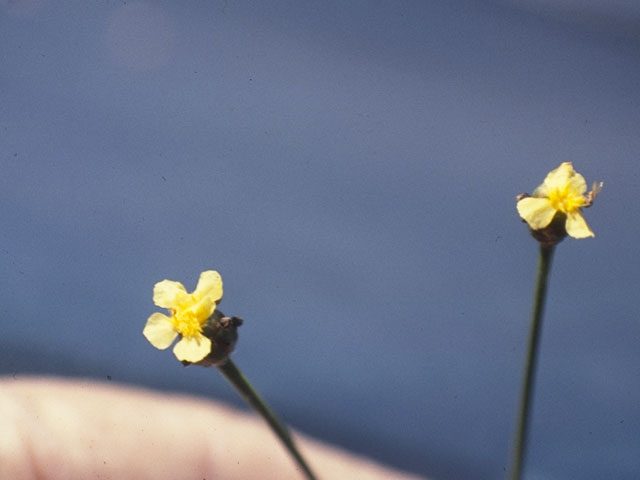Difference between revisions of "Xyris curtissii"
| Line 30: | Line 30: | ||
==Ecology== | ==Ecology== | ||
===Habitat=== <!--Natural communities, human disturbed habitats, topography, hydrology, soils, light, fire regime requirements for removal of competition, etc.--> | ===Habitat=== <!--Natural communities, human disturbed habitats, topography, hydrology, soils, light, fire regime requirements for removal of competition, etc.--> | ||
| − | ''W. curtissii'' occurs on savannas<ref name="Weakley 2015"/> containing moist or wet soils,<ref name="Kral 1960">Kral R (1960) The genus ''Xyris'' in Florida. Rhodora 62(743):295-319.</ref> including wet depression prairies. It is also found in moist pine woods.<ref name="Malme 1937"/> | + | ''W. curtissii'' occurs on savannas<ref name="Weakley 2015"/> containing moist or wet soils,<ref name="Kral 1960">Kral R (1960) The genus ''Xyris'' in Florida. Rhodora 62(743):295-319.</ref> including wet depression prairies.<ref name="Carr et al 2010">Carr SC, Robertson KM, |
| + | Peet RK (2010) A vegetation classification of fire-dependent pinelands of Florida. Castanea 75(2):153-189.</ref> It is also found in moist pine woods.<ref name="Malme 1937"/> | ||
===Phenology=== <!--Timing off flowering, fruiting, seed dispersal, and environmental triggers. Cite PanFlora website if appropriate: http://www.gilnelson.com/PanFlora/ --> | ===Phenology=== <!--Timing off flowering, fruiting, seed dispersal, and environmental triggers. Cite PanFlora website if appropriate: http://www.gilnelson.com/PanFlora/ --> | ||
Revision as of 15:08, 8 February 2018
| Xyris difformis | |
|---|---|

| |
| Photo by Robert L. Stone hosted at Wildflowers.org | |
| Scientific classification | |
| Kingdom: | Plantae |
| Division: | Magnoliophyta - Flowering plants |
| Class: | Liliopsida - Moncots |
| Order: | Commelinales |
| Family: | Xyridaceae |
| Genus: | Xyris |
| Species: | X. curtissii |
| Binomial name | |
| Xyris curtissii Kunth | |

| |
| Natural range of Xyris curtissii from USDA NRCS Plants Database. | |
Common Name: Curtiss's yellow-eyed grass[1][2]
Contents
Taxonomic Notes
Synonyms: X. difformis var. curtissii; X. bayardii; X. neglecta;[1][2] X. papillosa[2]
Description
Xyris curtissii is a monoecious perennial forb/herb.[2] However there is some suggestions that X. curtissii by be annual in northern portions of its range while individuals in the southern parts are biennial or perennial.[3] It has linear leaves 5-10 cm long and 2-4 mm wide and its sheath occupies 1/3 to 1/2 the length of the straw-colored tawny leaves. Seeds are ellipsoid and around 0.4 mm long.[4]
Distribution
This species occurs from southeastern Virginia, south to northeastern Florida and westward to southern Arkansas and east-central Texas. Disjunct populations are found in southern New Jersey and Central America.[1]
Ecology
Habitat
W. curtissii occurs on savannas[1] containing moist or wet soils,[3] including wet depression prairies.[5] It is also found in moist pine woods.[4]
Phenology
In the southeastern and mid-Atlantic United States, flowering occurs from July through August.[1]
Conservation and Management
Cultivation and restoration
Photo Gallery
References and notes
- ↑ 1.0 1.1 1.2 1.3 1.4 Weakley AS (2015) Flora of the Southern and Mid-Atlantic States. Chapel Hill, NC: University of North Carolina Herbarium.
- ↑ 2.0 2.1 2.2 2.3 USDA NRCS (2016) The PLANTS Database (http://plants.usda.gov, 07 February 2018). National Plant Data Team, Greensboro, NC 27401-4901 USA.
- ↑ 3.0 3.1 Kral R (1960) The genus Xyris in Florida. Rhodora 62(743):295-319.
- ↑ 4.0 4.1 Malme GOK (1937) Xyridacea. North American Flora 19(1):3-15.
- ↑ Carr SC, Robertson KM, Peet RK (2010) A vegetation classification of fire-dependent pinelands of Florida. Castanea 75(2):153-189.